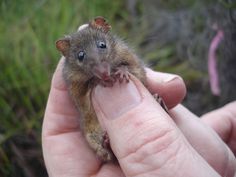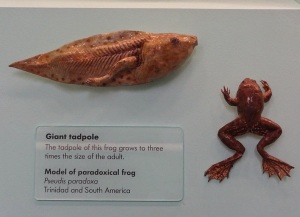Nature is well known for its extremes in pretty much every regard – variety, colours, sizes, dangerousness, smelliness, cuteness and what not. And while sometimes some natural features of organisms make sense (the warning bright colours of extremely poisonous frogs for example), in other case scientists still haven’t found the reasoning behind some extremes of nature – one of the most baffling areas being the babies of animals.
The smallest baby mammal at birth is believed to be the honey possum (Tarsipes rostratus). The babies of this species of marsupial (other marsupials are the kangaroos, wombats, koalas, and wallabies to name a few) are known to weight only 0.005 grams when born and gaining up to 2,5 grams by the time they are ready to leave the mother’s womb. Marsupials are the type of animals born at a very early stage of their development and need to spend certain amount of time in the pouch of the mother until they are fully developed and can venture on their own in the wild. So in this regard, it is not all that surprising that the honey possum is so small at birth, also because the full-grown examples of the species aren’t all that big to begin with. Nevertheless, this baby is extremely small weighting just 600 times less than a sugar cube.

On the other hand, the biggest baby to be born by a living creature today is the baby blue whale – it can be more than two tons heavy at birth. No surprise there – a big mom often (but not always) would give birth to a big baby. The baby whale drinks more than 200 litters for milk for as long as two years – no wonder they grow to be the biggest animals alive today!
But as I said – not always a big mother gives birth to a big baby. One of the most extreme cases is the so called paradoxical frog (Pseudis paradoxa). It is known as the shrinking frog because its tadpole can be as long as 25 cm and during its development it shrinks to a normal sized toad, roughly to a quarter of the size. Nobody really knows why the tadpole of this tropic frog is so much bigger than in its mature shape, but it might be a way to secure survival – being just too big for most of the common predators around.

One animal does not impress with the size of its babies – small or big, but rather with their number – the common tenrec (a hedgehog-like animal) in the wild has normally up to 30-32 babies, which to put it mildly is an achievement. The usual situation is that the maximum size of the litter of an animal would be the number of the tits the mother has so she could successfully nurse all the babies to maturity, but the most common size of the litter is the number of tits divided by 2, to make sure the mother has enough milk for all the babies for as long as necessary.
The length of the pregnancy does not necessarily correspond to the size of the baby which is born. Often it is the case – big babies require longer times in the uterus to develop and grow as much as they do. But the frilled shark is another extreme example – its one of the birth-giving sharks which is already impressive as is, but its babies develop so incredibly slow that the shark remains pregnant for as long as 3,5 years! “On the slow side”, but for different reasons, are the armadillos (along with bears and badgers). They have the little known ability to put their pregnancies on hold until the environmental conditions are much move favorable for the little one to survive. They happen to be able to postpone the implantation of the very early embryo without it dying and sometimes they can do that for a whole season if needed!
In general the gestation period is highly exhausting and energy-costly for the organism (most often the mother, but sometimes dads have all the responsibilities for the offspring, like the sea-horse for example). But there you have it – if you’ve thought that humans have it hard when pregnant, think again for instance of a mother elephant which is pregnant for almost 2 years with a its baby being as big as 90 kilograms and a meter tall!

I love this post! Very interesting.
Glad you enjoyed it! Was great fun writing it too 😀 tricky to choose just few tho…